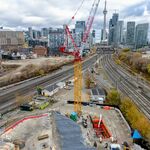Toronto's subway cars are lighter, less expensive and carry more people than a Flexity Freedom, so that point is moot. Same can be said about every other 'heavy rail' subway car out there. Toronto continues to have such large rolling stock because it demands it. The Same goes for Montreal and NYC. Building this line as a subway would not have been difficult to accomplish nor would it have significantly increased costs. The increased costs would have come from high-floor platforms and longer platforms (larger stations). Heavy rail has the capacity for the future, Light Rail generally does not. Ottawa has expanded their transit system conservatively over the past 30 years and they keep having to deal with the politics that come with any sort of relief. While the Confederation line will likely never need to require a full rebuild or relief line to increase capacity, I'm still surprised they chose to not just build the line as a full Heavy Rail EMU line or a Metro.
And new heavy rail subway/metro systems open up almost every year, 9 have opened up this year alone. Just because they aren't being built in Western countries doesn't mean they aren't being built at all. Cities that require heavy rail lines tend to already have systems in place, and expansion occurs all the time. Even in NA, Toronto, Montreal, Vancouver, DC, NYC, The Bay Area, Mexico City and more have seen expansions in the past 15 years and many more (including LA, Chicago, Philadelphia, and many of the aforementioned cities) are planning or building new lines and extensions. Heavy rail is not dead, we are just seeing a renaissance of lighter rail systems throughout the world, but especially in North America. Part of it is due to costs and concerns that capacity goals will be met, but part of it is also due to the fact that there is little room to build additional subway lines in certain cities.






